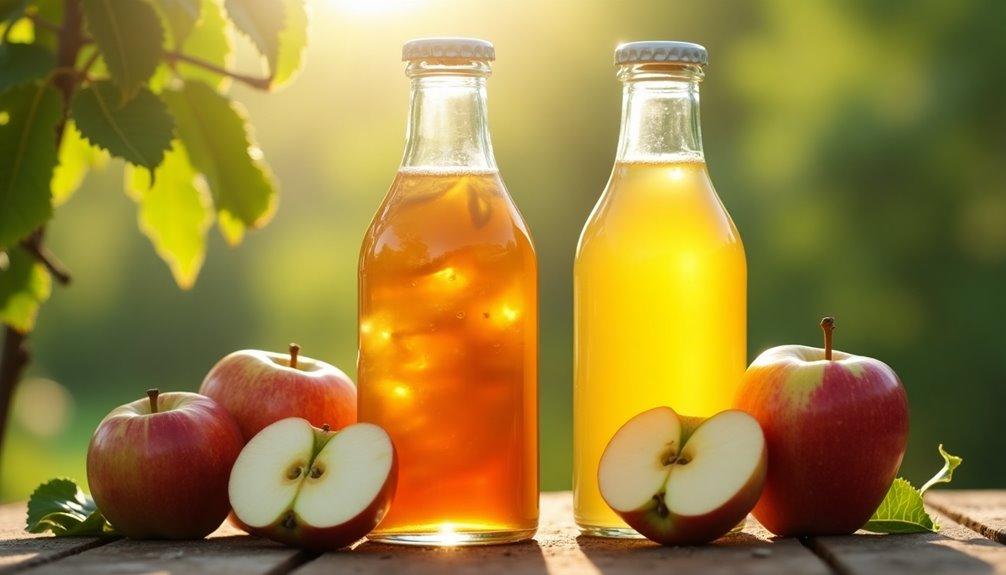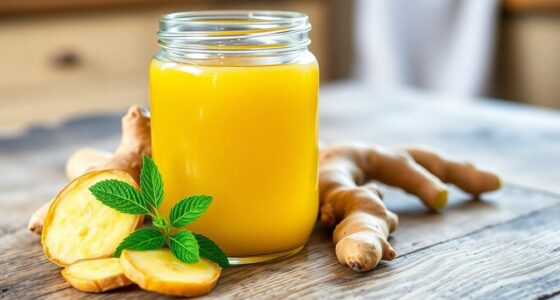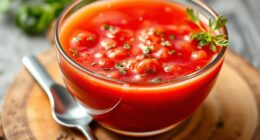Apple cider and apple juice might look alike, but they're quite different. Cider's murky, unfiltered appearance sets it apart from the clear, golden apple juice. Cider's sharp, tangy taste comes from no added sugars, while juice often contains sweeteners. Plus, cider has a shorter shelf life due to lack of preservatives. In the U.S., "cider" means non-alcoholic, which can be confusing. Learn more about how these differences affect your choice and enjoyment!
Key Takeaways
- Apple cider is unfiltered and murky, while apple juice is filtered and has a clear, light golden color.
- Apple cider is typically unpasteurized, preserving natural flavors without added sugars, unlike apple juice which is often pasteurized and sweetened.
- The taste of apple cider is sharper and more complex, while apple juice tends to be sweeter and milder.
- Apple cider has a short shelf life of about five days due to lack of preservatives, whereas apple juice can last longer and be stored at room temperature.
- In the U.S., "cider" refers to non-alcoholic apple cider, while "hard cider" indicates fermented apple beverages, distinguishing the two.

When you're deciding between apple cider and apple juice, it's important to know how they differ. At first glance, both drinks might seem similar, but when you dig a little deeper, you'll discover some significant distinctions that could influence your choice.
Apple cider is made from pressed fresh apples and is typically unfiltered. This unfiltered nature gives it a murky appearance, often accompanied by sediment that settles at the bottom. In contrast, apple juice is filtered, resulting in a clear, light golden color that looks refreshing in a glass. This visual difference is just the beginning of what sets these two beverages apart.
Another major difference lies in their processing. Apple juice is often pasteurized, which helps to extend its shelf life and ensures that harmful bacteria are eliminated. During this process, however, apple juice may also contain added sugars and preservatives to enhance its sweetness and longevity.
On the other hand, apple cider is usually unpasteurized and contains no added sugars, allowing the natural flavors of the fresh apples to shine through. This means that when you sip on apple cider, you're getting a more authentic apple experience, directly reflecting the fruit's natural taste.
Speaking of taste, the flavor profiles of apple cider and apple juice are quite distinct. Apple cider tends to have a sharper, tangier taste due to its unfiltered nature. This can create a more complex and robust flavor that many people find appealing, especially in the fall season when cider is particularly popular.
Conversely, apple juice is generally sweeter, thanks in part to the possible added sugars, making it more palatable for those who prefer a milder flavor. If you enjoy a drink that captures the essence of fresh apples without the sweetness, you might lean toward apple cider.
When it comes to shelf life, you’ll find yet another difference. Apple cider has a limited shelf life of about five days when refrigerated due to its lack of preservatives. In contrast, apple juice can be stored at room temperature until opened and lasts much longer because of its processing. This longer shelf life makes apple juice a more convenient option for those who prefer to stock up on their beverages. However, it’s important to note that once opened, apple juice should be refrigerated and consumed within a week for optimal freshness. On the other hand, if you’re enjoying homemade apple cider, be mindful of the fresh juice storage duration, as it requires quicker consumption to enjoy its natural flavors and benefits.
So, if you're planning to stock up or want something that can sit in your pantry for a while, apple juice might be the better option.
In the U.S., it's also essential to understand the terminology. The term "cider" typically refers to non-alcoholic apple cider, while "hard cider" denotes fermented apple beverages. This distinction helps you know exactly what you're drinking, separating it clearly from apple juice.
Frequently Asked Questions
Is Apple Cider Better for You Than Apple Juice?
When you compare apple cider to apple juice, you might find cider's benefits appealing.
It's often unfiltered, preserving more nutrients and antioxidants. Plus, cider typically contains no added sugars, making it a healthier option if you're watching your sugar intake.
Since cider has a robust flavor, you'll likely consume it in smaller amounts, which can help lower your overall sugar consumption.
Why Does Apple Juice and Apple Cider Taste Different?
Imagine biting into a crisp apple, the burst of flavor igniting your taste buds.
That's the essence of apple cider, with its tangy, robust profile, filled with bits of fruit and a hint of fermentation.
In contrast, apple juice smooths out those edges, offering a consistent sweetness, often enhanced by added sugars.
The difference lies in their textures and flavors, shaped by how they're made, leaving you with distinct experiences in every sip.
Can I Use Apple Juice in Place of Apple Cider?
Yes, you can use apple juice in place of apple cider, but keep a few things in mind.
Apple juice is sweeter and smoother, so it might change the flavor and texture of your dish. If you do substitute, consider reducing added sugars to balance the sweetness.
Also, be aware that apple juice's milder taste mightn't deliver the same robust flavor you're looking for, especially in recipes that rely on cider's tanginess.
Is Apple Cider Just Juiced Apples?
No, apple cider isn't just juiced apples.
While both start with apples, cider is made from freshly pressed apples and usually remains unfiltered, keeping the pulp and sediment. This gives it a richer texture and flavor profile.
In contrast, apple juice undergoes more processing, often filtering out those components and sometimes adding sweeteners.
Conclusion
In conclusion, while you might think apple cider and apple juice are the same, they offer distinct experiences. Cider's rich, unfiltered profile captures the essence of fresh apples, while juice tends to be sweeter and clearer. Some may argue that juice is just as good, but cider brings a depth of flavor and tradition that juice simply can't match. So, the next time you're choosing between the two, remember that cider is a celebration of the apple itself.
Cindy thoroughly researches juicing trends, techniques, and recipes to provide readers with practical advice and inspiration. Her writing style is accessible, engaging, and designed to make complex concepts easy to understand. Cindy’s dedication to promoting the advantages of juicing shines through her work, empowering readers to make positive changes in their lives through the simple act of juicing.











